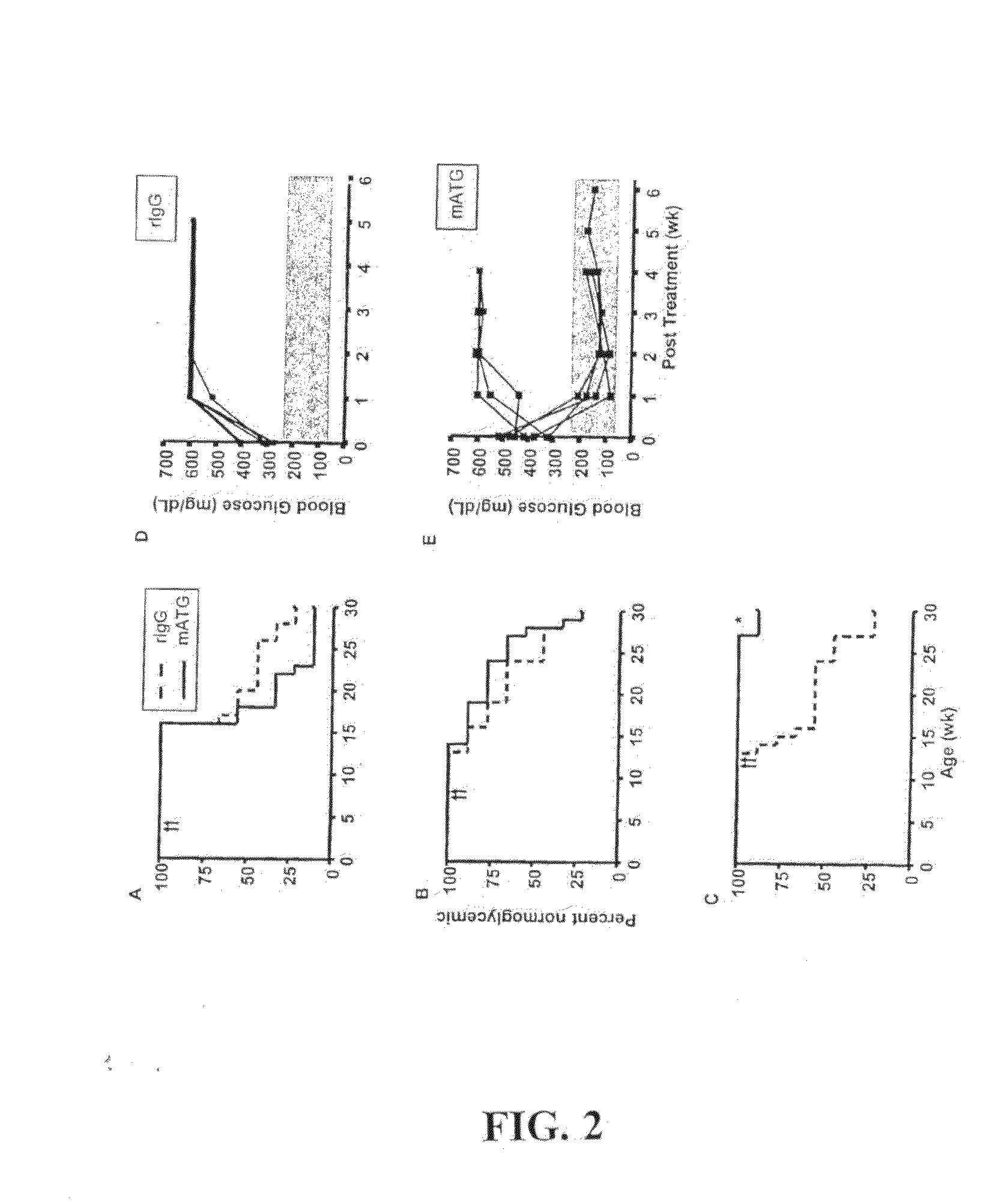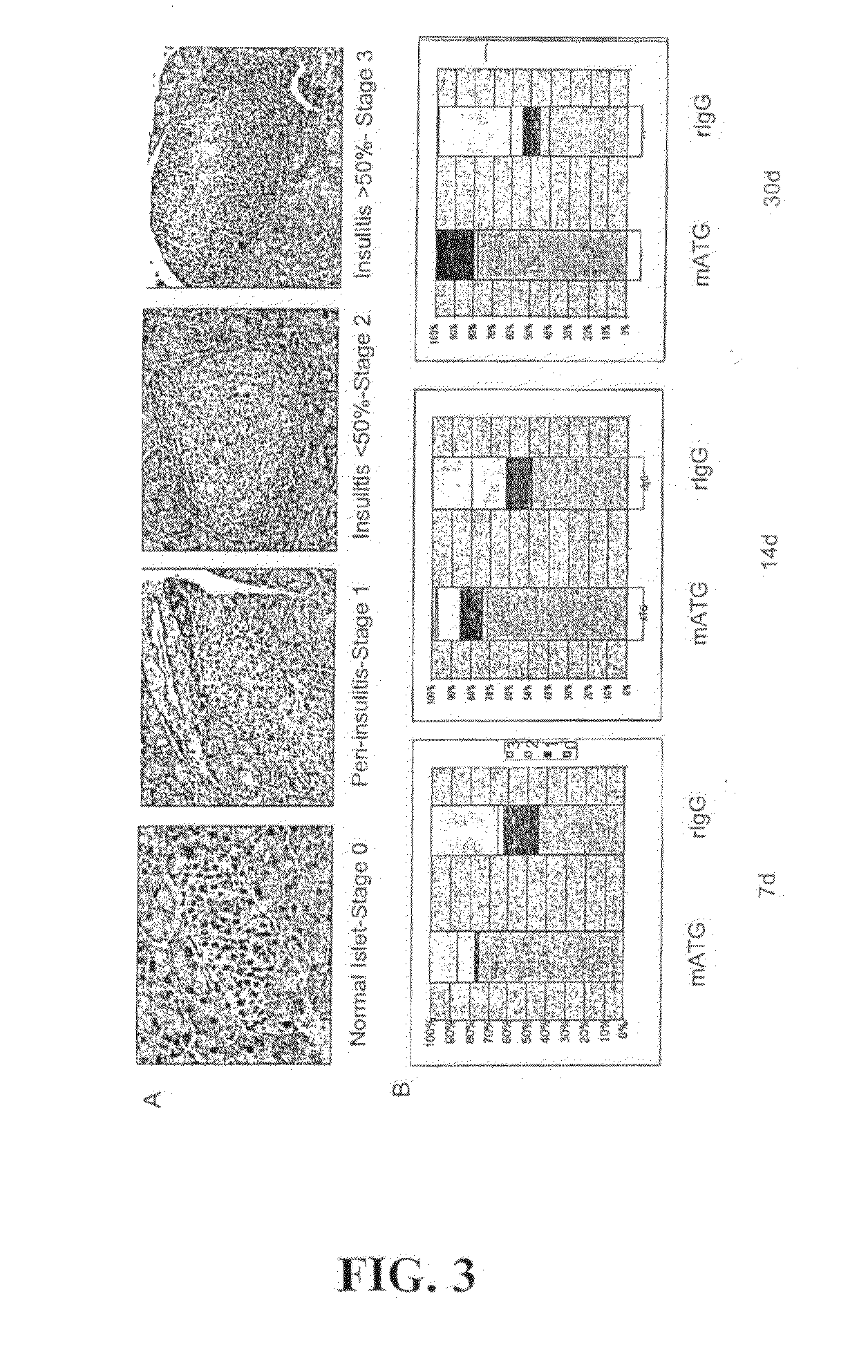Materials and Methods for Reversing Type-1 Diabetes
a type-1 diabetes and material technology, applied in the field of materials and methods for reversing type-1 diabetes, can solve the problems of impaired glucose metabolism with attendant complications, insufficient insulin production, eye, kidney function, etc., and achieve the effect of eliminating or reducing the need for insulin injections and preventing or delaying the onset of overt diseas
- Summary
- Abstract
- Description
- Claims
- Application Information
AI Technical Summary
Benefits of technology
Problems solved by technology
Method used
Image
Examples
example 1
Lymphocyte Depletion after Treatment with mATG
[0080]To evaluate whether the in vivo activities of mATG demonstrate strain specific differences in terms of its capacity for lymphocyte depletion, whole blood samples were collected at various times from 4, 8, or 12 week old NOD as well as Balb / C mice both prior to and up to 30 d following intraperitoneal administration of mATG. Treatment of both strains of mice with mATG induced a significant degree of lymphopenia within 1d (FIG. 1 A), but one which by 30 d post-administration, peripheral blood lymphocyte counts returned to pre-administration levels. No significant differences were observed in lymphocyte counts between mATG treated NOD and Balb / c mice at any treatment age (all P=NS); represented by similar patterns of depletion and subsequent restoration over a 30 d period (12 week data; FIG. 1A). Hence, mATG treatment imparts a period of transient lymphocyte depletion followed by a robust recovery of cells, with no age- or strain-depe...
example 2
Depletion of CD3+, CD4+, and CD8+ T Lymphocyte Populations is Transient Following mATG Treatment
[0081]To identify the actions of mATG on a variety of these T cell subsets and (potentially) uncover any bias in terms of its actions in vivo, flow cytometry was used to evaluate the levels of CD3+, CD4+, and CD8+ T cell populations 7, 14, and 30 d following treatment in NOD mice treated with mATG or rIgG. Treatment of NOD mice with mATG versus rIgG, imparted a transient decline in CD3+ T cells, (12.1±0.8% vs. 53.7±6.8%; respectively; P+ (FIG. 1C; 8.5±0.2% vs. 38.4±2.4%) and CD8+(FIG. 1D; 2.6±0.2% vs. 16.1±1.8%) T cell populations. Throughout this 30 d period, the CD4:CD8 ratio of the mATG treated mice was not significantly altered from rIgG treated mice (P=NS), nor were T-lymphocyte subsets of any rIgG treated mice reduced.
example 3
Transient Serum Cytokine Increases Follow mATG Treatment
[0082]Serum samples from mice were collected at 0, 1, 3, 6, 12, and 24 h as well as 3, 7, 14, and 30 d following treatment of NOD mice provided mATG or rIgG. A 21-plex Luminex® cytokine assessment was performed on each serum sample for cytokine profiling.
[0083]mATG imparted a cytokine release pattern in vivo that was marked by transient, but statistically significant increases in many cytokines (IL-1α, IL-1, IL-2, IL-4, IL-5, IL-6, IL-7, IL-9, IL-10, IL-12p70, IL-13, IL-15, IL-17, IFN-γ, TNF-α, GM-CSF, MP-1α, MCP-1, KC, RANTES, IP-10, and G-CSF). Indeed, of these, only G-CSF and IL-12 p70 were not significantly elevated in mATG versus rIgG treated mice. For example, serum IL-2 levels increased in mATG treated mice from an average baseline of less than 20±1.9 to 145±46.1 pg / mL within 12 h, but declined to baseline levels by d 3 (FIG. 1E). NOD mice treated with control rIgG did not exhibit a significant increase in any serum conc...
PUM
| Property | Measurement | Unit |
|---|---|---|
| time | aaaaa | aaaaa |
| body weight | aaaaa | aaaaa |
| humidity | aaaaa | aaaaa |
Abstract
Description
Claims
Application Information
 Login to View More
Login to View More - R&D
- Intellectual Property
- Life Sciences
- Materials
- Tech Scout
- Unparalleled Data Quality
- Higher Quality Content
- 60% Fewer Hallucinations
Browse by: Latest US Patents, China's latest patents, Technical Efficacy Thesaurus, Application Domain, Technology Topic, Popular Technical Reports.
© 2025 PatSnap. All rights reserved.Legal|Privacy policy|Modern Slavery Act Transparency Statement|Sitemap|About US| Contact US: help@patsnap.com



